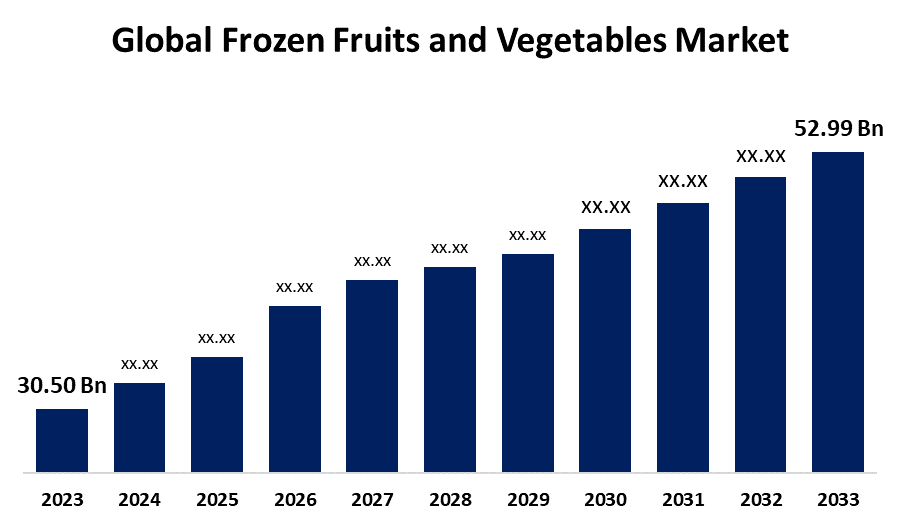Global Frozen Fruits and Vegetables Market Size, Share, and COVID-19 Impact Analysis, Type (Fruits and Vegetables), By Form (Whole, Sliced, and Cubed), By Distribution Channel (Supermarkets & Hypermarkets, Convenience Stores, Specialty Stores, Online, and Others), and By Region (North America, Europe, Asia-Pacific, Latin America, Middle East, and Africa), Analysis and Forecast 2023 - 2033.
Industry: Food & BeveragesGlobal Frozen Fruits and Vegetables Market Insights Forecasts to 2033
- The Global Frozen Fruits and Vegetables Market Size was estimated at USD 30.50 Billion in 2023
- The Market Size is Expected to Grow at a CAGR of around 5.68% from 2023 to 2033
- The Worldwide Frozen Fruits and Vegetables Market Size is Expected to Reach USD 52.99 Billion by 2033
- Asia Pacific is Expected to Grow the fastest during the Forecast period.

Get more details on this report -
The Global Frozen Fruits and Vegetables Market size was worth around USD 30.50 Billion in 2023 and is predicted to grow to around USD 52.99 Billion by 2033 with a compound annual growth rate (CAGR) of 5.68% between 2023 and 2033. The market for frozen fruits and vegetables is propelled by drivers such as increasing demand for convenience, long shelf life, and retention of nutrients. Growing health awareness, availability throughout the year, and the trend of plant-based diets also drive it. Growth in e-commerce, advancements in freezing technology, and sustainability trends further fuel market growth.
Market Overview
The frozen fruits and vegetables market is defined as the portion of the food business that involves the manufacturing, distribution, and sale of frozen fruits and vegetables. The items are usually harvested at their full ripeness, rapidly frozen to retain their nutritional contents, taste, and texture, and packaged for retail or bulk consumption. Frozen fruits and vegetables are widely used for their ease of use, longer shelf life, and year-round availability, even when the crop is out of season. They can be utilized in a variety of uses including domestic cooking, food service, and processed foods. Organic, preservative-free frozen produce and innovation, such as individual quick freezing (IQF) to provide better product quality. Further, there is also a discernible trend towards sustainable packaging and sustainability efforts as people become more green-conscious. Increased use of online grocery stores is also a prominent trend influencing the market. Furthermore, continuous developments in packaging technology like vacuum sealing and recyclable packaging increase product shelf life with reduced environmental degradation. As consumers are getting more discerning about the quality and sustainability of their food products these technological advancements are boosting demand for frozen fruits and vegetables, both in mature and developing markets.
Report Coverage
This research report categorizes the frozen fruits and vegetables market based on various segments and regions forecasts revenue growth and analyzes trends in each submarket. The report analyses the key growth drivers, opportunities, and challenges influencing the frozen fruits and vegetables market. Recent market developments and competitive strategies such as expansion, type launch, development, partnership, merger, and acquisition have been included to draw the competitive landscape in the market. The report strategically identifies and profiles the key market players and analyses their core competencies in each sub-segment of the frozen fruits and vegetables market.
Global Frozen Fruits and Vegetables Market Report Coverage
| Report Coverage | Details |
|---|---|
| Base Year: | 2023 |
| Market Size in 2023 : | USD 30.50 Billion |
| Forecast Period: | 2023 – 2033 |
| Forecast Period CAGR 2023 – 2033 : | 5.68% |
| 023 – 2033 Value Projection: | USD 52.99 Billion |
| Historical Data for: | 2019-2022 |
| No. of Pages: | 246 |
| Tables, Charts & Figures: | 108 |
| Segments covered: | By Product Type, By Form, By Distribution Channel |
| Companies covered:: | Ardo NV, Bonduelle Group, Findus Sverige AB, General Mills Inc., Lamb Weston Holdings Inc., McCain Foods Limited, Mirelite Mirsa Zrt, Pinnacle Foods Inc., Simplot Food Group, The Kraft Heinz Company, Vivartia SA, and Others |
| Pitfalls & Challenges: | COVID-19 Impact Analysis and Forecast 2023 - 2033 |
Get more details on this report -
Driving Factors
Frozen vegetables and fruits offer unmatched convenience to consumers. Having a long shelf life, they can be stored for long periods without spoiling, minimizing the need for constant grocery shopping. This is particularly attractive to busy people and households who want convenient-to-use ingredients that do not need to be consumed immediately, fueling its demand. Additionally, frozen vegetables and fruits are usually cheaper compared to fresh ones, especially during off-seasons or when fresh ones are in short supply. Because frozen produce is picked during peak seasons and stored, they are usually less susceptible to price imbalances due to weather conditions or transportation.
Restraining Factors
Freezing is energy-consuming and needs considerable electricity for cooling and storage. Energy consumed during freezing, storage, and transportation of frozen fruits and vegetables is among the high costs of frozen produce. In addition, having a cold chain from production through selling is important to be able to maintain the quality of the product, but it contributes to both energy use and environmental damage inhibiting the frozen fruits and vegetables market.
Market Segmentation
The frozen fruits and vegetables market share is classified into product type, form, and distribution channel.
- The vegetable segment dominated the market in 2023 and is projected to grow at a substantial CAGR during the forecast period.
Based on the product type, the frozen fruits and vegetables market is divided into fruits and vegetables. Among these, the vegetable segment dominated the market in 2023 and is projected to grow at a substantial CAGR during the forecast period. The growth is attributed to frozen veggies being consumed on a large scale in different forms, like in dishes, soups, stews, and other ready-to-cook foodstuffs. Peas, corn, carrots, spinach, and mixed vegetable packs are some of the most common frozen veggies. They are a staple in every household and are utilized repeatedly in daily cooking, which results in increased demand.
- The whole segment accounted for a significant share in 2023 and is anticipated to grow at a remarkable CAGR during the forecast period.
Based on the form, the frozen fruits and vegetables market is divided into whole, sliced, and cubed. Among these, the whole segment accounted for a significant share in 2023 and is anticipated to grow at a remarkable CAGR during the forecast period. The segmental growth is due to whole fruits and vegetables maintaining more of their natural nutrients, texture, and flavor than sliced or cubed ones. Cutting or slicing results in a larger surface area, which may result in the loss of nutrients during freezing and storage. Consequently, whole produce is favored by consumers who want to maintain freshness and nutrition.
- The supermarkets & hypermarkets segment accounted for the biggest share in 2023 and is anticipated to grow at a significant CAGR during the forecast period.
Based on the distribution channel, the frozen fruits and vegetables market is divided into supermarkets & hypermarkets, convenience stores, specialty stores, online, and others. Among these, the supermarkets & hypermarkets segment accounted for the biggest share in 2023 and is anticipated to grow at a significant CAGR during the forecast period. The growth is driven by hypermarkets and supermarkets are generally based in convenient, high-traffic locations, thus becoming easy shopping points for customers. They provide one-stop shopping as customers can get a wide variety of frozen items along with other foodstuffs, fueling high volumes of sales. Moreover, the bigger store size enables them to have more variety and greater quantity, thereby enhancing customer choice and leading to bulk buying.
Regional Segment Analysis of the Frozen Fruits and Vegetables Market
- North America (U.S., Canada, Mexico)
- Europe (Germany, France, U.K., Italy, Spain, Rest of Europe)
- Asia-Pacific (China, Japan, India, Rest of APAC)
- South America (Brazil and the Rest of South America)
- The Middle East and Africa (UAE, South Africa, Rest of MEA)
North America is anticipated to hold the largest share of the frozen fruits and vegetables market over the predicted timeframe.

Get more details on this report -
North America is anticipated to hold the largest share of the frozen fruits and vegetables market over the predicted timeframe. The growing need for convenience and ready-to-cook food in the U.S. is one of the major drivers for the frozen foods industry. Frozen vegetables and fruits provide the advantage of having fruits and vegetables ready to use, with a longer shelf life, which suits busy lifestyles. Frozen vegetables and fruits are perceived as a healthy option, as they are usually frozen at the peak of ripeness, preserving nutrients. North American health-conscious consumers are increasingly embracing frozen fruits and vegetables as a part of their healthy diet.
Asia Pacific is expected to grow at a rapid CAGR in the frozen fruits and vegetables market during the forecast period. With people in the Asia-Pacific increasingly having more Western eating styles, processed and ready-to-eat food, including frozen fruits and vegetables, is demanded more. It is most common in nations such as China and India, with rising middle class and evolving consumption patterns.
Competitive Analysis:
The report offers the appropriate analysis of the key organizations/companies involved within the frozen fruits and vegetables market along with a comparative evaluation primarily based on their type of offering, business overviews, geographic presence, enterprise strategies, segment market share, and SWOT analysis. The report also provides an elaborative analysis focusing on the current news and developments of the companies, which includes type development, innovations, joint ventures, partnerships, mergers & acquisitions, strategic alliances, and others. This allows for the evaluation of the overall competition within the market.
List of Key Companies
- Ardo NV
- Bonduelle Group
- Findus Sverige AB
- General Mills Inc.
- Lamb Weston Holdings Inc.
- McCain Foods Limited
- Mirelite Mirsa Zrt
- Pinnacle Foods Inc.
- Simplot Food Group
- The Kraft Heinz Company
- Vivartia SA
- Others
Key Target Audience
- Market Players
- Investors
- End-users
- Government Authorities
- Consulting And Research Firm
- Venture capitalists
- Value-Added Resellers (VARs)
Recent Development
- In March 2024, BigBasket and celebrity chef Sanjeev Kapoor recently launched Precia, a frozen foods brand dealing in frozen vegetables, snacks, and sweets. The company uses Individual Quick Freezing (IQF) technology to lock in the taste and nutritional content, with the vision to take a sizeable market share in the frozen food industry.
Market Segment
This study forecasts revenue at global, regional, and country levels from 2023 to 2033. Spherical Insights has segmented the frozen fruits and vegetables market based on the below-mentioned segments:
Global Frozen Fruits and Vegetables Market, By Product Type
- Fruits
- Vegetables
Global Frozen Fruits and Vegetables Market, By Form
- Whole
- Sliced
- Cubed
Global Frozen Fruits and Vegetables Market, By Distribution Channel
- Supermarkets & Hypermarkets
- Convenience Stores
- Specialty Stores
- Online
- Others
Global Frozen Fruits and Vegetables Market, By Regional Analysis
- North America
- US
- Canada
- Mexico
- Europe
- Germany
- UK
- France
- Italy
- Spain
- Russia
- Rest of Europe
- Asia Pacific
- China
- Japan
- India
- South Korea
- Australia
- Rest of Asia Pacific
- South America
- Brazil
- Argentina
- Rest of South America
- Middle East & Africa
- UAE
- Saudi Arabia
- Qatar
- South Africa
- Rest of the Middle East & Africa
Need help to buy this report?